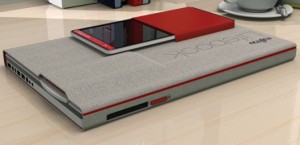Want a quick glimpse of the future of high tech gear? Maybe these products will not see the light of day but a recent concept contest by Fujitsu has shown some great product ideas for a range of technologies.
Naturally a number caught my eye but one combo product really had me thinking that it would be interesting to own. The product was a combination notebook computer, tablet, smartphone and digital camera-but not as an all-in-one solution but rather as removable parts of a whole.
The concept design, which is on the short list in the Fujitsu Design Competition 2011 was created by designer Prashant Chandra which he named “Lifebook 2013”. It is designed to both provide a user with all of the tech tools that they might be carrying and put them into one slim, highly integrated package.
The drive behind the design is not just a gimmicky form factor that enables users to have a convenient place to keep all of their devices together. As additional devices are added their functions and capabilities are added as well.
Add the camera and get a high end digital imaging device as part of your notebook.
Add your phone you have communications, possibly your MP3 collection and other features. A tablet could serve as a second display or as a keyboard, helping to keep the weight down. Syncing all of a users devices should be a snap under a design like this.
But a key differentiator would be that the processors that are stored in the individual devices could also be tasked with some of the laptop’s functions as well.
If this device did manage to come to market in some form in the near future Fujitsu would have to exercise absolute control over both software and hardware design. Code would need to be written to enable programs to take advantage of the different processors, and to adapt when some processors or hardware are not present.
It would also have to be aware of what is and is not present so that it can alter its abilities in real time. A user would not want to constantly change settings when using a phone.
One hidden advantage is that a user might be able to use their smartphone as the communications device for the notebook and tablet without getting contracts for those devices. If nothing else it might serve to push telcos to offer better bundles so that a person can reasonably afford to have cellular capabilities on multiple devices with a reasonable contract covering them all. Ah to dream.







